THE 80 MOST INSPIRING ASIAN AMERICANS OF ALL TIME
PAGE 8 OF 8
Nos. 1-10
Nos. 11-20
Nos. 21-30
Nos. 31-40
Nos. 41-50
Nos. 51-60
Nos. 61-70
Nos. 71-80
GOLDSEA | ASIAMS.NET | ASIAN AMERICAN PERSONALITIES
THE 80 MOST INSPIRING ASIAN AMERICANS OF ALL TIME
71. Morgan Chu Morgan Chu is America's most admired Asian big-firm lawyer. His success is entirely of the blue-chip variety. At 55 he's already a top powerhouse at one of California's most admired and profitable law firms. At a time when most legal behemoths were reeling from the tech slump, Irell & Manella partner Chu was routinely commanding annual draws well into the seven figures.
Morgan Chu is America's most admired Asian big-firm lawyer. His success is entirely of the blue-chip variety. At 55 he's already a top powerhouse at one of California's most admired and profitable law firms. At a time when most legal behemoths were reeling from the tech slump, Irell & Manella partner Chu was routinely commanding annual draws well into the seven figures.
Some would consider Chu's tendencies and life philosophy as embodying anything but those of a big firm lawyer. His educational path would be a horror story to parents with conventional ambitions for their kids. He began at UCLA with a BA in poli sci in 1971, followed by a masters in an interdisciplinary major called urban educational policy planning in 1972, then a PhD in law and social policy in 1973. A year later he managed to get an obscure degree called an MsL, masters in studies in law, from Yale. Why not just go to law school? Eventually Chu arrived at that conclusion, getting a J.D. from Harvard. That was his 5th degree in 5 years!
After joining Irell & Manella, Chu made 1978 when he won a jury verdict in the very first trial ever on a software patent. At the time he began working on that case Chu had been with the first just one year and had neither patent nor trial experience. After that historic verdict, he became the firm's patent tiral lawyer. That put him in a position to win some of the biggest patent verdicts on record, including a $500-million verdict for City of Hope in 2002 on a patent suit against biotech giant Genentech. Soon after, he won a $120 million verdict against Microsoft representing little-known Stac Electronics. Those kinds of verdicts won Chu not only newspaper headlines but the acclaim of his peers: he has been named one of the top 10 trial lawyers in the U.S. as well as patent litagator of the year.
Not bad for a guy who had to work his way through that long and winding college career. "For a year or two I hashed at a sorority house -- so that was a lot of my meals," Chu recalls, "and worked in dormitories -- switchboard and the mail -- and usually had three or so part-time jobs at the same time. So I had more than enough to live on." He met wife Helen as a UCLA student while they were volunteering as ESL teachers to immigrant Chinese children. Chu maintains that his hobbies are "running long distance slowly, butchering golf courses, falling down ski slopes and swallowing water while swimming, and traveling."
72. Indra Nooyi
 Indra Nooyi completed her climb to the top of Pepsico in August of 2006 when she was promoted from CFO to replace the retiring CEO. Her achievement is all the more remarkable because she didn't come to the U.S. until the age of 23. Her impact on Pepsi's fortunes made her Fortune's 11th most powerful woman in business for 2005. Since joining Pepsi in 1994 Nooyi led its 1998 acquisition of Tropicana frozen orange juice business and helped work out its spinoff of Taco Bell, KFC and Pizza Hut as Tricon Global Restaurants in 1997. In August 2001 PepsiCo acquired Quaker Oats. It is now the world's second largest beverage company after Coca-Cola and fourth largest food and beverage company with 142,000 employees around the world.
Indra Nooyi completed her climb to the top of Pepsico in August of 2006 when she was promoted from CFO to replace the retiring CEO. Her achievement is all the more remarkable because she didn't come to the U.S. until the age of 23. Her impact on Pepsi's fortunes made her Fortune's 11th most powerful woman in business for 2005. Since joining Pepsi in 1994 Nooyi led its 1998 acquisition of Tropicana frozen orange juice business and helped work out its spinoff of Taco Bell, KFC and Pizza Hut as Tricon Global Restaurants in 1997. In August 2001 PepsiCo acquired Quaker Oats. It is now the world's second largest beverage company after Coca-Cola and fourth largest food and beverage company with 142,000 employees around the world.
Nooyi received her B.A. from Madras Christian College, a Management degree from the Indian Institute of Management in Calcutta and a Yale MBA. She began her career as a management consultant with Boston Consulting Group (BCG). She moved to Motorola, then Asea Brown Boveri, rising steadily up the ranks to senior management. Nooyi is a Successor Fellow at Yale Corporation and serves on the board of directors of Motorola, the Federal Reserve Bank of New York and the Lincoln Center for the Performing Arts. She lives in Greenwich, Connecticut with husband Rajkishan and two daughters.
73. John Okada
 John Okada's No-No Boy is recognized as both the first Japanese American novel and one of the most intensely felt and authentic novels of the Asian American experience. When it was first released in 1957 (Charles Tuttle) Okada's one and only published novel received virtually no attention from the Japanese American community. It was exactly the wrong story at the wrong time for people trying to put the troubling internment years behind them and fit into a socially rigid America. It wasn't until several years after Okada died, discouraged and unknown, of a heart attack in 1971 (another Pig year) that No-No Boy was discovered by Asian Americans.
John Okada's No-No Boy is recognized as both the first Japanese American novel and one of the most intensely felt and authentic novels of the Asian American experience. When it was first released in 1957 (Charles Tuttle) Okada's one and only published novel received virtually no attention from the Japanese American community. It was exactly the wrong story at the wrong time for people trying to put the troubling internment years behind them and fit into a socially rigid America. It wasn't until several years after Okada died, discouraged and unknown, of a heart attack in 1971 (another Pig year) that No-No Boy was discovered by Asian Americans.
Ironically, had John Okada modeled his protagonist Ichiro after himself, the novel might have enjoyed a better reception from a community eager to prove itself as a true-blue part of America that had done its part in the War and was embracing the American Dream. Instead, he was drawn into the personal history of an acquaintence named Hajime "Jim" Akutsu who had been interned in Minidioka, Idaho. In 1943 Akutsu had answered "no" and "no" to the infamous Questions 27 and 28 of the loyalty questionnaire administered to male internees in 1943. Question 27 asked whether the respondent was willing to serve in the U.S. armed forces. Question 28 asked whether he was willing to "forswear allegiance" to the Japanese emperor. In response to these offensive questions Akutsu had obeyed his indignant heart and responded in the negative. That had made him a "No-No Boy", marked as disloyal to a nation that had betrayed him. A year later Akutsu was convicted as a draft resister and imprisoned for two years.
John Okada was born in 1923 in Seattle. He served in the Air Force during World War II, attaining the rank of sergeant. After receiving B.A. degrees from the University of Washington in both English and library science, he earned a masters in English literature from Columbia University. Okada embodied the kind of mainstream credentials to which many in the Japanese American community aspired. By all appearances John Okada was a "Yes-Yes Boy". But his novel captured the inner torment all Japanese Americans endured over their racial identities. Ultimately, No-No Boy looks beyond the Japanese American identity to trace the deep veins of racism that divide Asian from White, White from Black, Black from Asian.

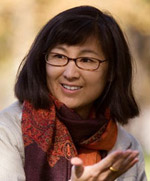 Despite several other monuments that show admirable devotion to the unity of form and function, Maya Lin's fame is based on a design she submitted as a 21-year-old Yale senior to the national Vietnam Veterans Memorial competition. When Lin's design was picked from among 1,400, many veteran's groups denounced it as a "gash of shame". But once the Monument was completed in 1982, even the harshest critics came to appreciate the subtle but compelling visual logic of the polished walls of black granite from southern India.
Despite several other monuments that show admirable devotion to the unity of form and function, Maya Lin's fame is based on a design she submitted as a 21-year-old Yale senior to the national Vietnam Veterans Memorial competition. When Lin's design was picked from among 1,400, many veteran's groups denounced it as a "gash of shame". But once the Monument was completed in 1982, even the harshest critics came to appreciate the subtle but compelling visual logic of the polished walls of black granite from southern India.
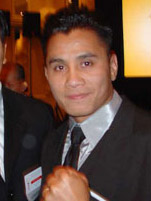 As a world champion who had gone undefeated in 16 matches, Vietnamese American kickboxing master Cung Le had nothing left to prove in the sport of san shou, a form of Chinese kung fu that rewards aggressive strikes and takedowns but does not allow grappling. Having won his last san shou-rules match in a Strikeforce light heavyweight bout against Frank Shamrock protegé Brian Ebersole June 4, 2005 at the HP Pavilion by unanimous decision, Le was widely regarded the country's most dominant kickboxing champion. At the age of 32, there would have been no shame in retiring from competition and devoting his energy to building up his fight gear business and captaining the U.S. san shou team in international competition.
As a world champion who had gone undefeated in 16 matches, Vietnamese American kickboxing master Cung Le had nothing left to prove in the sport of san shou, a form of Chinese kung fu that rewards aggressive strikes and takedowns but does not allow grappling. Having won his last san shou-rules match in a Strikeforce light heavyweight bout against Frank Shamrock protegé Brian Ebersole June 4, 2005 at the HP Pavilion by unanimous decision, Le was widely regarded the country's most dominant kickboxing champion. At the age of 32, there would have been no shame in retiring from competition and devoting his energy to building up his fight gear business and captaining the U.S. san shou team in international competition.
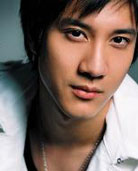 Any Asian American who has ever felt that, in an Asian-centric world, he might have become a pop star instead of a doctor, accountant or computer engineer can point to Leehom Wang. Not only has Wang attained international pop stardom, he has done it while coining a new, uniquely Asian genre. His "chinked-out" music incorporates tribal sounds from China, Tibet, and Mongolia with more classical influences to create a sound that feels culturally rooted. Heroes of Earth, his most recent album, takes typical pop candy chords and infuses them with strains that could only have come from the Beijing Opera.
Any Asian American who has ever felt that, in an Asian-centric world, he might have become a pop star instead of a doctor, accountant or computer engineer can point to Leehom Wang. Not only has Wang attained international pop stardom, he has done it while coining a new, uniquely Asian genre. His "chinked-out" music incorporates tribal sounds from China, Tibet, and Mongolia with more classical influences to create a sound that feels culturally rooted. Heroes of Earth, his most recent album, takes typical pop candy chords and infuses them with strains that could only have come from the Beijing Opera.
 New York City Councilman John Liu directed public outrage against hip-hop DJ Troi Torain for calling the half-Asian wife of a rival DJ a "slant-eyed whore". Torain was fired by WWPR-FM (Power 105.1). The next day the New York City Police Hate Crimes Unit arrested Torain for endangering the welfare of a child.
New York City Councilman John Liu directed public outrage against hip-hop DJ Troi Torain for calling the half-Asian wife of a rival DJ a "slant-eyed whore". Torain was fired by WWPR-FM (Power 105.1). The next day the New York City Police Hate Crimes Unit arrested Torain for endangering the welfare of a child.
 During his decade as Solectron's CEO Koichi Nishimura led the company to become the world's largest, most profitable provider of electronics manufacturing services. His winning strategy was to implement an industry-leading feedback system that lets employees respond quickly to customer needs and market conditions. During his tenure as CEO, Solectron's contract manufacturing clientele came to include elite brands like IBM, Cisco, Dell Computers, Nortel Networks, Lucent Technologies, Hewlett-Package, Sun Microsystems and Sony.
During his decade as Solectron's CEO Koichi Nishimura led the company to become the world's largest, most profitable provider of electronics manufacturing services. His winning strategy was to implement an industry-leading feedback system that lets employees respond quickly to customer needs and market conditions. During his tenure as CEO, Solectron's contract manufacturing clientele came to include elite brands like IBM, Cisco, Dell Computers, Nortel Networks, Lucent Technologies, Hewlett-Package, Sun Microsystems and Sony.
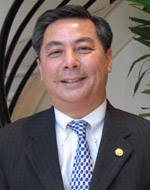 Texans may soon be thanking Hubert Vo for a common-sensical new law. Vo's bill, which recently passed the state senate, would force utilities to accept the postmark date as the date on which a bill is paid. Its uncertain whether that bill will pass the conference committee, but Vo is used to uncertainty. He won his first term as a state legislator in 2004 by 16 votes! And that was after enduring a recount forced by the losing incumbent.
Texans may soon be thanking Hubert Vo for a common-sensical new law. Vo's bill, which recently passed the state senate, would force utilities to accept the postmark date as the date on which a bill is paid. Its uncertain whether that bill will pass the conference committee, but Vo is used to uncertainty. He won his first term as a state legislator in 2004 by 16 votes! And that was after enduring a recount forced by the losing incumbent.
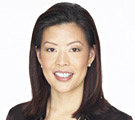 Don't let anyone tell you that your B.S. in electrical engineering from MIT and Stanford MBA just aren't worth the sheepskin they're printed on. Look at Andrea Wong. She reverse-leveraged those degrees into a research gopher gig at ABC 14 years ago, then clawed her way up to head that network's reality and late-night shows. Wong is credited with firing up ABC's ratings with hot reality shows like Dancing with the Stars, The Bachelor and Extreme Makeover: Home Edition. On April 26, 2007 Wong was tapped to infuse life into the Lifetime Network which went from the top of the cable heap to sixth place the past several years.
Don't let anyone tell you that your B.S. in electrical engineering from MIT and Stanford MBA just aren't worth the sheepskin they're printed on. Look at Andrea Wong. She reverse-leveraged those degrees into a research gopher gig at ABC 14 years ago, then clawed her way up to head that network's reality and late-night shows. Wong is credited with firing up ABC's ratings with hot reality shows like Dancing with the Stars, The Bachelor and Extreme Makeover: Home Edition. On April 26, 2007 Wong was tapped to infuse life into the Lifetime Network which went from the top of the cable heap to sixth place the past several years.